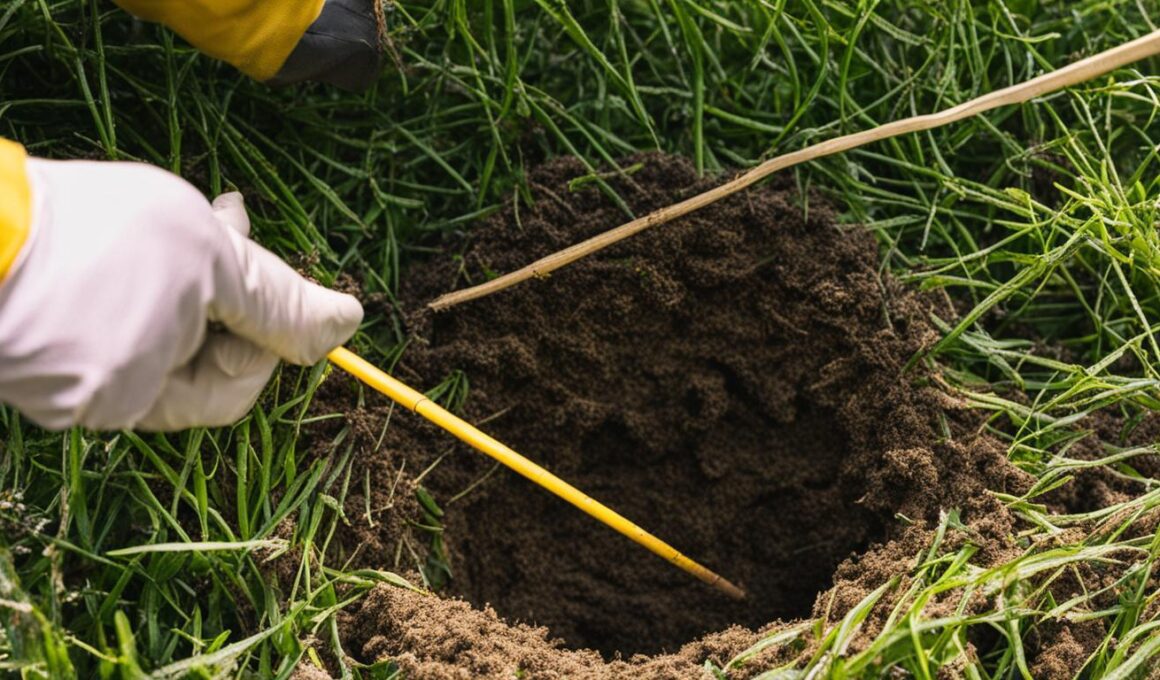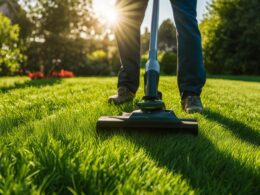Are you tired of dealing with yellow jacket nests in your yard? These aggressive insects can pose a threat with their multiple stings, making your outdoor space unsafe and uncomfortable. If you’re looking to get rid of yellow jacket nests in the ground, we’ve got you covered. In this article, we will discuss effective removal tips that will help you maintain a sting-free yard.
When it comes to eliminating ground yellow jacket nests, there are various methods you can use. From professional extermination to DIY options, each approach has its pros and cons. The right method for you will depend on the size and accessibility of the nest, as well as your personal preferences and safety concerns.
Key Takeaways:
- Yellow jackets are aggressive insects that can pose a threat with their multiple stings.
- There are various methods for removing yellow jacket nests in the ground.
- Professional extermination is a highly effective and safe option for large nests or allergies to stings.
- Aerosol insecticides are a quick solution for above-ground nests, but may not be suitable for larger colonies.
- Insecticidal dust is effective for ground nests, but caution is required during application.
The Role of Yellow Jackets and Signs of Infestation
Yellow jackets, known as natural bug killers, play a crucial role in controlling the population of beetles, caterpillars, and spiders. They are highly efficient hunters, often feeding on these common garden pests. However, their presence can become a problem when they build nests in the ground, especially near areas frequently visited by people.
Identifying the signs of a yellow jacket infestation is essential for effective pest management. In many cases, infestations go unnoticed until the nest is accidentally disturbed or during periods when large numbers of yellow jackets are seen flying in and out. These signs indicate the presence of an active nest, alerting you to take action.
To recognize the signs of a yellow jacket infestation, pay attention to the following:
- Frequent Fly-bys: If you notice a substantial number of yellow jackets flying in a particular area, it could indicate the presence of a nest nearby.
- Ground Nest Activity: Yellow jackets typically build their nests underground, in abandoned animal burrows or other underground cavities. Keep an eye out for increased insect activity near the ground, particularly around holes or entrances.
- Visible Nest Material: Occasionally, you may see yellow jacket nest material, such as chewed wood fibers or papery substance, near their nest location.
- Multiple Entry Points: If you observe yellow jackets entering and exiting a particular area, it is a strong indication of a nest. Yellow jackets tend to use the same entrance, causing noticeable traffic around that spot.
Locating the Nest
Locating the yellow jacket nest is the crucial first step in successfully eliminating the infestation. Once you have identified the signs of a nest, carefully observe the flight path of the yellow jackets to track the location. Avoid getting too close or disturbing the nest, as it may provoke aggressive behavior and increase the risk of stings.
Remember, proper pest control measures should be taken if the infestation poses a threat to human health or if it interferes with daily activities. Taking the necessary steps to remove yellow jacket nests from your property will ensure a safer and more enjoyable environment.
Professional Extermination
Hiring a licensed pest control expert is the most reliable and effective method for eliminating yellow jacket nests. When dealing with a large nest or if you have allergies to stings, it’s crucial to seek the expertise of a professional exterminator. These experts have the necessary experience and specialized equipment to locate and eliminate nests safely.
Professional exterminators not only eliminate the immediate problem but also provide long-term solutions to prevent future infestations. They can offer valuable advice on additional prevention strategies to ensure a pest-free environment. While professional extermination may be more expensive than DIY methods, it guarantees professional expertise, effective elimination, and reduces the risk of recurring infestations.
When it comes to the safety and well-being of your home and family, investing in professional extermination is a worthwhile choice. Their knowledge, experience, and access to professional-grade treatments provide a higher level of effectiveness and long-lasting results.
Aerosol Insecticide
If you’re dealing with above-ground yellow jacket nests and need a quick solution, aerosol insecticides can be an effective option. These specialized products are designed to freeze the nest’s inhabitants, causing them to freeze to death. This freezing action provides a fast and efficient way to eliminate smaller yellow jacket colonies or when immediate results are desired.
When using aerosol insecticides, it’s important to note that they may not be suitable for large nests. Additionally, approaching the nest carries a risk of getting stung, so exercise caution when using this method. Nonetheless, aerosol insecticides can be a valuable tool in your pest control arsenal for above-ground nest removal.
Image: A can of aerosol insecticide, a quick solution for above-ground yellow jacket nests.
Insecticidal Dust
When dealing with ground nests of yellow jackets, insecticidal dust can be an effective method for elimination. Common insecticides such as carbaryl or permethrin can be applied directly into the nest entrance. It is recommended to perform this task during the nighttime when the yellow jackets are less active.
The advantage of using insecticidal dust is that it is carried into the nest by the yellow jackets themselves. As they come into contact with the dust, they are exposed to its insecticidal properties, leading to the elimination of the entire colony. This residual control method ensures that not only the visible yellow jackets are eradicated, but also the underground nests, ultimately addressing the root of the problem.
It is important to note that in the case of large nests, the insecticidal dust may not reach the entire colony. In such instances, caution should be exercised to prevent provoking aggressive behavior from the yellow jackets. Additionally, ensure proper protective equipment and follow the instructions provided with the specific insecticidal dust product.
To visually illustrate the process, refer to the image below:
Diatomaceous Earth and DIY Traps
A natural and non-toxic option for controlling yellow jacket infestations is diatomaceous earth. This organic control acts as a physical barrier, damaging the exoskeletons of the insects and leading to dehydration and death. It is an effective method for deterring and controlling yellow jackets, especially in areas where direct access to the nest is challenging.
Additionally, DIY traps can be utilized as part of your pest control strategy. These traps can effectively attract and trap yellow jackets using pheromones or sweet baits, such as fruit juice or sugary water. DIY traps are not only affordable but also eco-friendly, offering a sustainable approach to pest management.
However, it’s important to note that while diatomaceous earth and DIY traps can significantly reduce yellow jacket populations, they may not eliminate the entire colony. Therefore, these methods should be used in conjunction with other control measures for optimal results.
By incorporating diatomaceous earth and DIY traps into your pest control plan, you can effectively manage yellow jacket infestations in a safe and environmentally conscious way. Remember to prioritize the safety of yourself and others when applying these methods, and consider consulting with a professional exterminator for severe or recurring infestations.
Conclusion
When it comes to ground yellow jacket nest removal, there are several safe and effective strategies to choose from. Your decision should be based on factors such as the size of the nest, its accessibility, and personal preferences.
Professional extermination is the most reliable and long-term solution, especially for large nests or if you have allergies to stings. Hiring a licensed pest control expert will ensure the efficient elimination of yellow jacket nests and provide ongoing prevention strategies to keep your yard sting-free.
If you prefer a DIY approach, options like aerosol insecticides, insecticidal dust, diatomaceous earth, DIY traps, dishwashing detergent, and liquid insecticides can be effective alternatives. These methods offer different advantages and considerations, allowing you to tackle the problem in a way that suits your needs and priorities.
Regardless of the method you choose, prioritizing safety is crucial throughout the removal process. Always follow the instructions carefully and take necessary precautions to prevent stings. By selecting the right approach, you can ensure a successful yellow jacket nest removal and enjoy a peaceful and sting-free yard.
How Much Does it Cost to Remove a Ground Yellow Jacket Nest?
When dealing with ground yellow jacket nests, it’s crucial to consider the grass removal cost guide. The average cost to remove a ground yellow jacket nest is around $100-$300. However, prices may vary depending on the size and location of the nest. It’s best to consult a professional for an accurate estimate.
FAQ
How can I get rid of a yellow jacket nest in the ground?
There are several methods you can use to eliminate a yellow jacket nest in the ground. You can hire a licensed pest control expert for professional extermination, or you can try DIY options such as aerosol insecticides, insecticidal dust, diatomaceous earth, DIY traps, dishwashing detergent, or liquid insecticides. The method you choose will depend on the size and accessibility of the nest, as well as your personal preferences and safety concerns.
What is the role of yellow jackets in nature?
Yellow jackets play a crucial role as bug killers in nature. They hunt and feed on beetles, caterpillars, and spiders, helping to control the population of these pests and maintaining the balance of ecosystems. However, when yellow jackets build nests in the ground near areas frequented by people, they can become a serious problem and pose a threat with their multiple stings and aggressive behavior.
What are the signs of a yellow jacket infestation?
Signs of a yellow jacket infestation often go unnoticed until the nest is accidentally disturbed or large numbers of yellow jackets are seen flying in and out. Some of the signs to look out for include an increase in yellow jacket activity, sightings of yellow jackets near the ground, loud buzzing sounds near the nest, and the presence of chewed wood or soil around the nest entrance. Identifying the location of the nest is the first step in getting rid of them.
Should I hire a professional exterminator to eliminate a yellow jacket nest?
Hiring a licensed pest control expert is a highly effective and safe option for eliminating yellow jacket nests, especially if dealing with a large nest or if you have allergies to stings. Professional exterminators have the experience and specialized equipment to locate and eliminate nests, as well as provide ongoing prevention strategies. While it may be more expensive than DIY methods, professional extermination offers a comprehensive solution and reduces the risk of future infestations.
How does aerosol insecticide work for eliminating yellow jacket nests?
Aerosol insecticides designed to freeze yellow jacket nests work by rapidly cooling the inhabitants of the nest, causing them to freeze to death. This method is suitable for above-ground nests and can provide a fast and effective solution, especially for smaller colonies or when a quick result is needed. However, it may not be suitable for large nests, and there is a risk of getting stung when approaching the nest.
How does insecticidal dust work for eliminating yellow jacket nests?
Insecticidal dust, such as carbaryl or permethrin, can be applied directly into the nest entrance when yellow jackets are less active at night. This method is most effective for ground nests, as the dust is carried into the nest by the insects themselves, eliminating the entire colony. However, it may not reach the entire colony in large nests, and caution is needed when applying the dust.
What is diatomaceous earth and how can it help control yellow jackets?
Diatomaceous earth is a natural and non-toxic option for controlling yellow jacket infestations. It acts as a physical barrier, damaging the exoskeletons of the insects and leading to dehydration and death. It is suitable for deterring and controlling yellow jackets in areas where direct access to the nest is challenging. DIY traps can also be effective, using pheromones or sweet baits to attract and trap the wasps. These traps are affordable and eco-friendly but may not eliminate the entire colony.
What are some safe and effective strategies for removing yellow jacket nests in the ground?
To safely and effectively remove yellow jacket nests in the ground, it is important to consider the nest size, accessibility, and personal preferences. Hiring a professional exterminator is the most effective and long-term solution. Alternatively, you can try DIY methods like aerosol insecticides, insecticidal dust, diatomaceous earth, DIY traps, dishwashing detergent, or liquid insecticides. Remember to prioritize safety and choose the method that best suits your needs for a sting-free yard.











